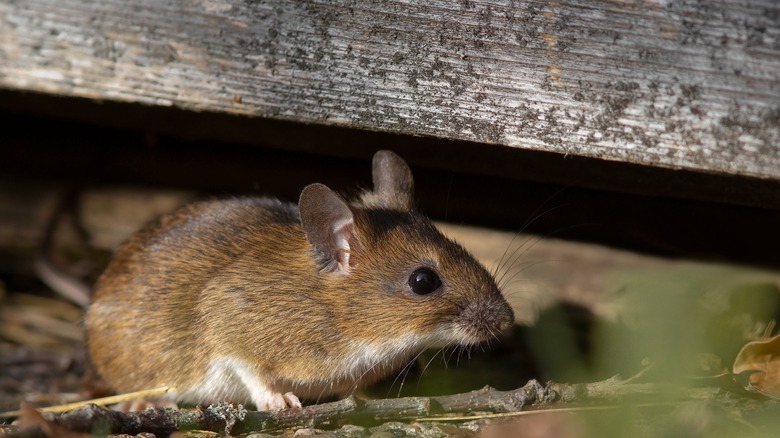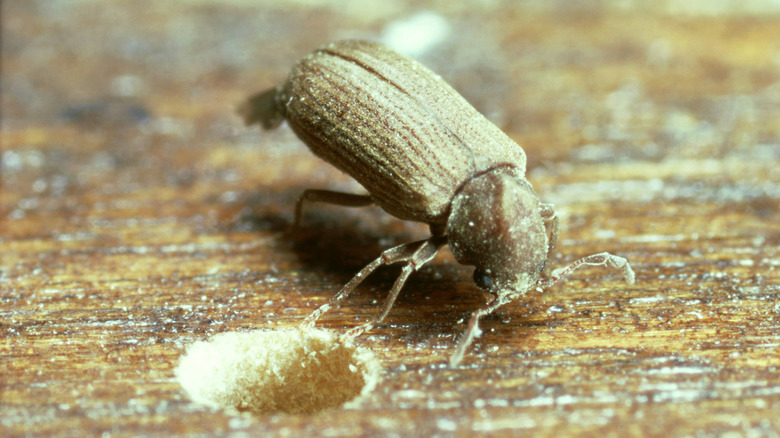Pests That Will Do By Far The Most Damage To Your Household
It's no secret that bugs and rodents can wreak major havoc on your house. In fact, in a survey conducted by Forbes, nearly half the respondents noted that their homes had been damaged by pests in some way. What's more, a single pest control visit can easily cost $500 even if the infestation is caught early. And, for severe cases, you could end up paying thousands.
The reality is, there are a lot of different types of pests and each brings their own unique set of pretty significant problems. They can put your home's structural integrity at risk, cause house fires, and put your family in danger of disease and bacteria. Luckily, you don't have to hand over your house to these uninvited guests. There are some simple preventative measures you can take to protect your home, as well as steps you can take if they've already made it inside. Here are ten of the most damaging pests as well as ways to fight them.
Termites could destroy your home's structure
Termites cause approximately $5 billion in property damage each year in the United States alone! Repairs for a single home can cost $3,000, which is why these are one of the primary pests to watch out for. These bugs feed on fibers found in wood, so they can eat away at the foundations of your home. Termite damage can cause doors and windows to stick, floors and ceilings to bulge, and wooden furniture to break. Eventually, it could lead to significant safety risks and a collapsing building.
Unfortunately, because these insects can cause so much structural damage, professional pest control is the best way to combat them. However, you can take steps to protect your home by watching for early signs, such as droppings, shed skin, or bits of dead insects. You're most likely to find these around windows, baseboards, or in and around wooden furniture. If you spot these warning signs or actual termite damage, it's a good idea to have the professionals come and take a look as soon as possible.
Rodents are risky
There are several different rodents that can cause problems for homeowners. From mice to rats to squirrels, these small mammals can get into your home and cause a lot of harm. Most rodents need to chew constantly because their teeth grow continuously. This means they will gnaw on furniture, clothes, toys, and even electrical wires, which can lead to house fires. Mice and rats also carry many diseases as well as fleas and ticks. So, having them running through your kitchen poses a significant health risk to you and your family.
If you have a rodent problem, you will probably notice their teeth marks, their droppings, or the animals themselves scurrying across the floor. If you do spot a mouse or rat, lay out non-lethal traps to catch them, and release them in an outdoor location far from your home. Then, walk around the exterior walls to find and patch the holes that these rodents used to get inside in the first place. If you keep your kitchen clean and seal openings, you'll have a better chance of deterring these pests.
Carpenter bees destroy wood
Another wood-destroying pest is the carpenter bee. These flying insects look a lot like bumblebees but can cause a lot of damage to the exterior of your home. Carpenter bees, unlike termites, don't actually eat any part of the wood. Instead, they use it as a nesting spot. The females will tunnel into soft wood to lay their eggs. So, the insects can quickly compromise the integrity of outdoor stairs, benches, porches, and other structures.
The main way to prevent carpenter bees is not to leave any exposed wood. Instead, paint, seal, or varnish all outdoor lumber. You also want to make timely repairs to any cracks or damage to deck boards. Once the surface is damaged, it is easier for carpenter bees to make their homes inside. Another way to deter them is to use hardwood species rather than softer options like pine or cedar for outdoor construction. This makes it much harder for the insects to tunnel and nest near your home.
Woodworms ruin home and furniture
Another species to add to the list of wood-ruining pests is the woodworm. The term is actually used to refer to the larvae of a few different types of beetle. The common furniture beetle, house longhorn beetle, powderpost beetle, and death watch beetle all eat wood when they are in the larvae stage. They can be found gnawing away at your furniture, your floorboards and baseboards, doors and window sills, and anywhere else there is wood available to them.
You might discover that you have an infestation because you are seeing fully grown beetles around the house. Or, you might spot hard pellets made of dust and excrement that they drop behind them when they are tunneling through your furniture. In the worst cases, you'll know you have a problem because you discover the damage. To fix an infestation, replace all affected wood with new lumber that has been treated with a permethrin-based treatment. In fact, for the best prevention, it's a good idea to treat any exposed lumber to avoid encountering these pests.
Bed bugs stubbornly bite
Although these tiny insects don't directly damage your home, they are included on this list because of how many problems they can cause for members of your household. Bed bugs multiply quickly, are difficult to kill, and cause a lot of discomfort for any people who are exposed to an infestation. These small bugs live in soft dark areas, like your mattress, couch, and clothes. They leave small bites that can lead to infection or allergic reactions in some cases and can be itchy and painful for weeks even in the best cases.
The best treatment for bed bugs is prevention. Whenever you travel, check seats, beds, and floors for dead bug pieces, excrement stains, or live insects. If you see anything suspicious, move yourself and your luggage away. If you think you've been exposed, it's a good idea to treat your clothes with either extreme heat or cold. If you do have bed bugs in your home, you can still kill them by heating or freezing them, but you'll need to perform multiple treatments since this will only kill the adults and eggs may still hatch, causing a second wave of problems.
Cockroaches can cause illness
You may consider cockroaches to be a harmless pest, but in reality, they can bring a lot of problems with them. Not only are they notoriously hard to kill, but they also reproduce quickly and can turn into an infestation within just days. The main reason these insects are problematic for homeowners is because they can carry a lot of diseases with them. In fact, cockroaches are contaminated with many different bacteria and pathogens, including salmonella, E. Coli, and even tuberculosis. While it isn't clear whether or not these are easily transmittable to humans, it's not a risk that's worth taking.
The reason cockroaches come inside is to find food. Therefore, the best way to avoid a problem is to never leave food out. Clean the kitchen well, including difficult-to-access areas like under the fridge or behind the oven. If you have spotted a roach or two, you can try sprinkling insect-repelling cinnamon around suspected entry points. Just the smell of the spice can drive the bugs to seek food elsewhere.
Silverfish can spread rapidly
Silverfish are attracted to cool damp areas, like basements and attics. Once they make their way into your home, they can spread throughout various spaces and leave excrement. In fact, silverfish lay eggs constantly, so they can very quickly become a big problem. The reason these insects are considered harmful to have in your home is because they can contaminate food. Often, they will get into dry goods like oats and rice. In addition, their excrement can leave stains. And, as if that isn't enough, the insects also eat paper and fabric. So, they can damage books and clothing around your home.
One of the main steps for preventing them from getting in is checking the exterior of your home for any cracks or holes. Additionally, a dehumidifier can help make sure that your storage spaces aren't holding in damp air. There are also some common food products that you can use to deter silverfish. Placing cucumber peels, a sprinkle of cinnamon, or a few cloves at common entry points can help keep them away, since they are repelled by these smells.
Rice weevils are pantry invaders
A common pantry pest, rice weevils are often brought into homes with contaminated food. As the name suggests, they are often found in rice but can feed off many other grains as well. These are small brown beetles that eat dried goods. Unfortunately, any food they get into could be contaminated and needs to be disposed of. Rice weevils reproduce very quickly, so if you don't catch them soon enough that can easily ruin an entire pantry.
Luckily, getting rid of these pests isn't usually too difficult. You'll need to carefully check every container of dried goods in your pantry and toss any that have any signs of infestation. Check for the adult bugs, eggs, dead bugs, or excrement. You can also use sticky traps to help identify just how far they have spread through your kitchen. In order to prevent them, carefully check bags of rice, wheat, and other grains when you purchase and make sure they don't have any signs of the insects.
Moths may destroy your wardrobe
Similar to silverfish, many species of moth can cause damage to fabric and paper materials. It isn't actually the adults that eat fabric, but their larvae. Therefore, it's important to keep them away so they can't reproduce. Most often, a moth will lay its eggs in a damp, dark, quiet part of your home. They can damage belongings that are in storage or in rooms that aren't used frequently.
If you suspect that there are eggs or larvae in your home, you'll want to address it immediately before they reach adulthood and start the cycle again. One way to treat an infestation is to use either heat or cold to kill the larva. You may also be able to get rid of them by thoroughly cleaning all fabrics. You can prevent future problems by storing fabrics and paper in airtight containers or by using mothballs to keep them away.
Wasps can inflict pain
Stinging insects can be damaging both to your house and yourself. Wasps and hornets can, of course, inflict painful stings that can cause incredibly dangerous allergic reactions. Even without an allergy, a sting can cause weeks of discomfort. In addition to their risk to humans, wasp nests can also damage the exterior of your house. They can be difficult to remove and can be the cause of broken shingles and siding or wood damage.
There are a few different ways to get rid of wasps. These include spraying the nest with a mixture of soap and water, pouring boiling water down the nest, or using herbal scents like lemongrass and cloves to prevent them in the first place. If you are going to try and get rid of a nest on your own, it is imperative that you wear proper protective gear and take all necessary precautions to avoid being stung by an entire hive. If you're leery or allergic, call professional pest control for help.










